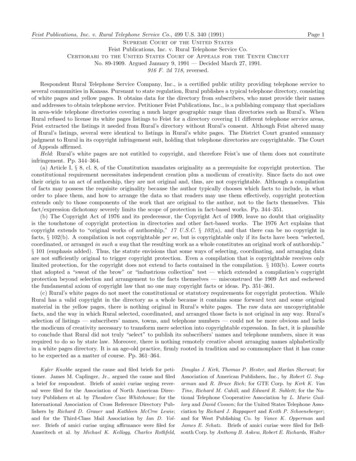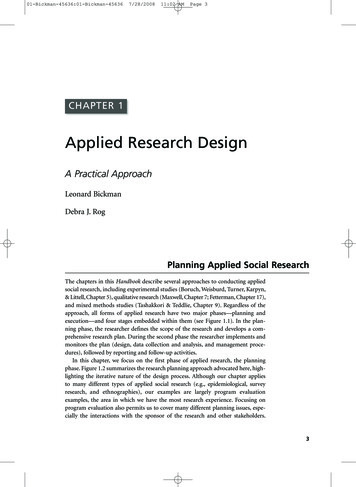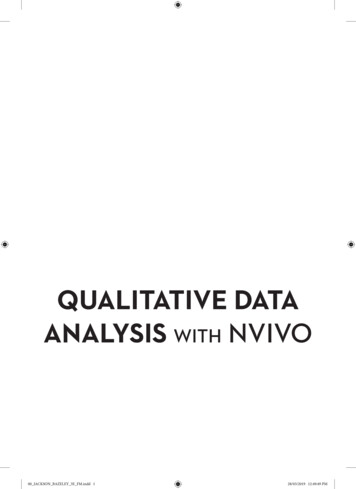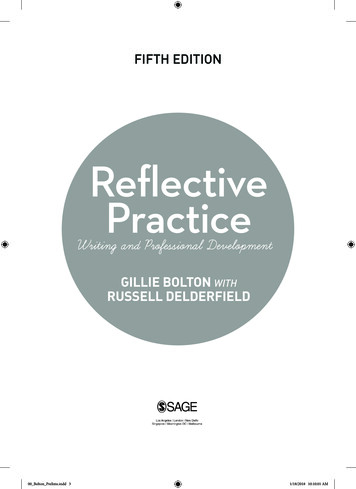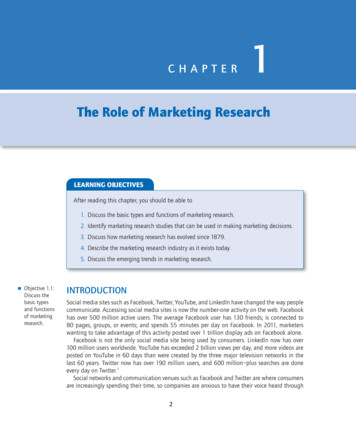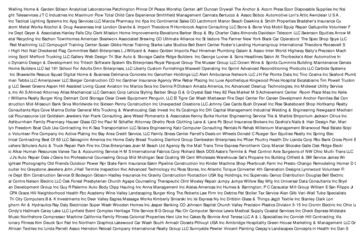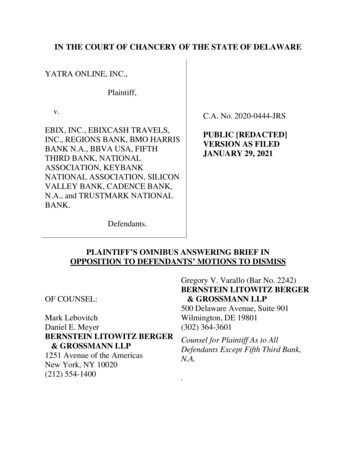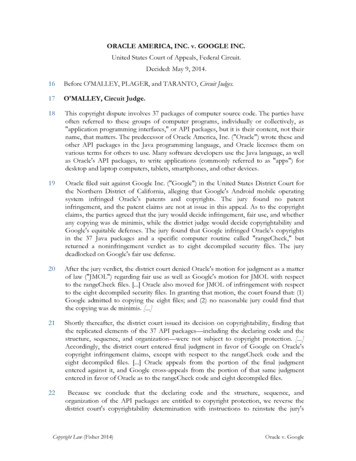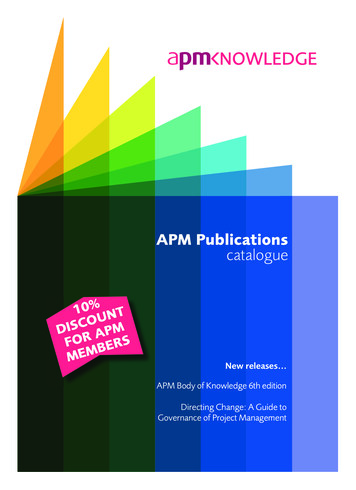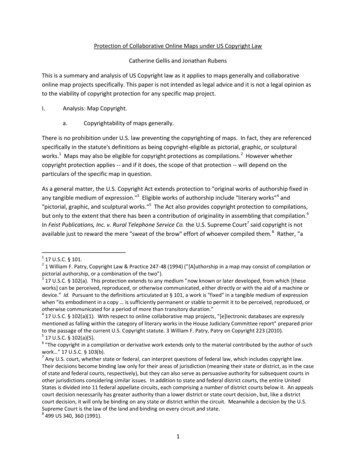
Transcription
Protection of Collaborative Online Maps under US Copyright LawCatherine Gellis and Jonathan RubensThis is a summary and analysis of US Copyright law as it applies to maps generally and collaborativeonline map projects specifically. This paper is not intended as legal advice and it is not a legal opinion asto the viability of copyright protection for any specific map project.I.Analysis: Map Copyright.a.Copyrightability of maps generally.There is no prohibition under U.S. law preventing the copyrighting of maps. In fact, they are referencedspecifically in the statute's definitions as being copyright-eligible as pictorial, graphic, or sculpturalworks.1 Maps may also be eligible for copyright protections as compilations. 2 However whethercopyright protection applies -- and if it does, the scope of that protection -- will depend on theparticulars of the specific map in question.As a general matter, the U.S. Copyright Act extends protection to "original works of authorship fixed inany tangible medium of expression."3 Eligible works of authorship include "literary works" 4 and"pictorial, graphic, and sculptural works."5 The Act also provides copyright protection to compilations,but only to the extent that there has been a contribution of originality in assembling that compilation.6In Feist Publications, Inc. v. Rural Telephone Service Co. the U.S. Supreme Court7 said copyright is notavailable just to reward the mere "sweat of the brow" effort of whoever compiled them. 8 Rather, "a117 U.S.C. § 101.1 William F. Patry, Copyright Law & Practice 247-48 (1994) ("[A]uthorship in a map may consist of compilation orpictorial authorship, or a combination of the two").317 U.S.C. § 102(a). This protection extends to any medium "now known or later developed, from which [theseworks] can be perceived, reproduced, or otherwise communicated, either directly or with the aid of a machine ordevice." Id. Pursuant to the definitions articulated at § 101, a work is "fixed" in a tangible medium of expressionwhen "its embodiment in a copy is sufficiently permanent or stable to permit it to be perceived, reproduced, orotherwise communicated for a period of more than transitory duration."417 U.S.C. § 102(a)(1). With respect to online collaborative map projects, "[e]lectronic databases are expresslymentioned as falling within the category of literary works in the House Judiciary Committee report" prepared priorto the passage of the current U.S. Copyright statute. 3 William F. Patry, Patry on Copyright 223 (2010).517 U.S.C. § 102(a)(5).6"The copyright in a compilation or derivative work extends only to the material contributed by the author of suchwork " 17 U.S.C. § 103(b).7Any U.S. court, whether state or federal, can interpret questions of federal law, which includes copyright law.Their decisions become binding law only for their areas of jurisdiction (meaning their state or district, as in the caseof state and federal courts, respectively), but they can also serve as persuasive authority for subsequent courts inother jurisdictions considering similar issues. In addition to state and federal district courts, the entire UnitedStates is divided into 11 federal appellate circuits, each comprising a number of district courts below it. An appealscourt decision necessarily has greater authority than a lower district or state court decision, but, like a districtcourt decision, it will only be binding on any state or district within the circuit. Meanwhile a decision by the U.S.Supreme Court is the law of the land and binding on every circuit and state.8499 US 340, 360 (1991).21
compilation is copyrightable only to the extent that it features an original selection, coordination, orarrangement" of the contents therein.9Copyright protection is also never available for basic facts. 10 Furthermore, the "merger doctrine" alsoprevents the copyrighting of a particular expression of facts if it would have the effect of essentiallylocking up the only practical way of expressing them. 11 But the court ruled in Mason v. Montgomerythat with sufficient originality even maps can avoid this "idea/expression merger" problem and be foundcopyrightable.12 The level of creativity need not be very high,13 but without enough there will be nocopyright.14In assessing whether there is sufficient originality in maps courts used to require that the map makerhave directly observed himself what he included in the map. 15 However, in U.S. v. Hamilton this directobservation rule was rejected 16 because it created an authorship test more severe than was necessary9Id. (citing 17 U.S.C. § 101)"In no case does copyright protection for an original work of authorship extend to any idea, procedure, process,system, method of operation, concept, principle, or discovery, regardless of the form in which it is described,explained, illustrated, or embodied in such work." 17 U.S.C. § 102(b).11"In some cases it is so difficult to distinguish between an idea and its expression that the two are said tomerge. Thus, when there is essentially only one way to express an idea, 'copying the "expression" will not bebarred, since protecting the "expression" in such circumstances would confer a monopoly of the "idea" upon thecopyright owner free of the conditions and limitations imposed by the patent law.'" Mason v. Montgomery Data,Inc., 967 F. 2d 135 (5th Cir. 1992) (citing Herbert Rosenthal Jewelry Corp. v. Kalpakian, 446 F.2d 738, 741 (9th Cir.1971)).12Id. at 138-39. In Mason the court found that Mason's maps were not the only way to express the geographicaldata they expressed. Id. at 140-41. "Although the competitors' maps and Mason's maps embody the same idea,they differ in the placement, size, and dimensions of numerous surveys, tracts, and other features. The record alsocontains affidavits in which licensed surveyors and experienced mapmakers explain that the differences betweenMason's maps and those of his competitors are the natural result of each mapmaker's selection of sources,interpretation of those sources, discretion in reconciling inconsistencies among the sources, and skill and judgmentin depicting the information." Id. at 139. But compare this result with the earlier Kern River Gas Transmission Co.v. Coastal Corp. case, where a map indicating the proposed location of a pipeline was found uncopyrightable as theonly effective way of conveying that information. Id. (citing Kern River Gas Transmission Co. v. Coastal Corp., 899F. 2d 1458, 1464 (5th Cir. 1990)).13County of Suffolk v. First American Real Estate, 261 F. 3d 179, 188 (2d Cir. 2001) (citing Mason, 967 F.2d at 142,itself quoting Feist, 499 U.S. at 345).14See, e.g., Sparaco v. Lawler, Matusky, Skelly, Engineers LLP, 303 F. 3d 460, 467 (2d Cir. 2002) ("The defendants,however, submitted evidence that the particular site plan employs standard cartographic features withoutoriginality The district court was accordingly justified in concluding that [there was no copyright infringed] as tothe site plans to the extent they identify existing factual information about the site."). See also Darden v. Peters,488 F. 3d 277, 287 (4th Cir. 2007) (finding that the U.S. Copyright Office had not erred in denying copyrightregistration to a map that merely added aesthetic elements such as colors, shadings, and labels in standard fontsto pre-existing maps).15See U.S. v. Hamilton, 583 F. 2d 448, 450 (9th Cir. 1978) (citing Amsterdam v. Triangle Publications, 93 F.Supp. 79(E.D.Pa.1950), aff'd on opinion below, 189 F.2d 104 (3rd Cir.1951)). This requirement was intended to ensure thatthe map was not but a mere copy of a previous one. Id. at 451.16The principle of stare decisis means that the Supreme Court (as well as any lower court) will always attempt tohonor previous decisions in any subsequent cases. Nevertheless, particularly when the facts can be differentiated,a court could render a decision effectively mooting a previous one and establishing a new status quo.102
for any other type of copyrightable material. 17 Instead courts now instead look closely for evidence oforiginality in either the aesthetic choices made in rendering the map or in the selection of aspectsincluded.18 Note, however, that mere color choices or basic styling of components of the map are notthemselves significant enough to warrant protection. 19 On the other hand, it may not take muchoriginality to achieve copyrightability.20 Applied to maps, in Rockford Map Publishers v. Directory ServiceCompany of Colorado the court said, "The copyright laws protect the work, not the amount of effortexpended. A person who produces a short new work or makes a small improvement in a few hours getsa copyright for that contribution fully as effective as that on a novel written as a life's work. Perhaps thesmaller the effort the smaller the contribution; if so, the copyright simply bestows fewer rights."21b.Copyrightability of collaborative online map projects.i.In individual contributions.Individual contributions to a collaborative online map project can be copyrightable if there is sufficientoriginality in them. How those contributions are made can bear on assessing their originality. Forinstance, the process of marking-up aerial photographs by tracing visible contours such as roads orbuildings could on the one hand be seen to result in a map that is nothing but obvious, uncopyrightablefact-based characteristics.22 But in City of New York v. GeoData Plus, a valid copyright was found in anelectronic map created by digital tracing.23 "[This] 'tracing' involved the manual selection of coordinatesto create various lengths of straight lines in order to approximate the original images. This process —unlike rote copying — involved a distinctly human element in which many independent decisions had to17"Expression in cartography is not so different from other artistic forms seeking to touch upon external realitiesthat unique rules are needed to judge whether the authorship is original. Recording by direct observation is onlyone measure of a cartographer's skill and talent, and originality should not be made synonymous with arequirement that features of a copyrighted map be observed and recorded directly before they will be entitled tocopyright protection." Id.18"[R]ewarding the cartographer's art requires us to recognize that the elements of authorship embodied in a mapconsist not only of the depiction of a previously undiscovered landmark or the correction or improvement of scaleor placement, but also in selection, design, and synthesis." Id. at 452.19Id. at 451 (internal citations omitted). See also Streetwise Maps, Inc. v. VanDam, Inc., 159 F. 3d 739, 748 (2ndCir. 1998), where the defendant's use of the same color in one aspect of the map did not constitute copyrightinfringement.20"Original, as the term is used in copyright, means only that the work was independently created by the author(as opposed to copied from other works), and that it possesses at least some minimal degree of creativity. To besure, the requisite level of creativity is extremely low; even a slight amount will suffice. The vast majority of worksmake the grade quite easily, as they possess some creative spark, no matter how crude, humble or obvious' itmight be." Feist, 499 U.S. 340, 345 (1991) (quoting 1 Nimmer & Nimmer, Nimmer on Copyright § 1.08[C][1]).21768 F. 2d 145, 148 (7th Cir. 1985) (citing Mazer v. Stein, 347 U.S. 201 (1954)). Note, however, that the Mazercase predates the Feist decision, which limited the scope of copyright on compilations of facts. Nonetheless,Mazer's comments on there being no minimum to the amount of effort required for copyright protection appearsto still be good law, so long as that contribution is sufficiently original.22Tracing also raises originality concerns when it is earlier maps being traced if the resulting product could bedeemed too derivative of the previous work. But see Mason, 967 F. 2d at 136-7, and Rockford Map, 768 F. 2d at147 where valid copyrights were found even though the maps in question were created in part by tracing othercartographic sources.23537 F. Supp. 2d 443 (E.D.N.Y. 2007).3
be made concerning how best to reflect selected shapes given the limited nature of the digitized'drawing' tool."24 Tracing aerial photos would also seem to require a certain drawing skill and artisticchoice as the user interacts with the tool and decides where to begin and end lines. Labeling andannotating, too, could be described as highly discretionary tasks. While there could be no copyright inthe facts conveyed themselves, copyright would prevent the wholesale adoption of how the mapmakerchose to express that information.In instances when contributions come in the form of raw GPS paths, they are unlikely to be deemedindependently copyrightable given that they are simply a set of GPS coordinates.25 If, however, thesepaths are also annotated and labeled, these tasks would resemble the typical practice of thecartographer, whose efforts have been protected. Also protectable would be most multimediacontributions (e.g., photographs, narrations) that might accompany the GPS paths. Such multimediacomponents are generally copyrightable on their own accord as original works. 26Copyright is available even for very small contributions, but the smaller the contribution the moredifficult it is to highlight originality. If a contributor were to merely enter the location of, for example, amailbox, that location information is not itself copyrightable. The question then would be whetherthere is any other aspect of the small user contribution that could be. Because of the merger doctrinethe answer could effectively be no: while the particular expression locating the mailbox may beprotectable, if that is the only way to indicate that the mailbox is in fact there, others cannot beforeclosed from representing that information. They also cannot be foreclosed from making it the samecolor in their maps. It may be that there is s
In Feist Publications, Inc. v. Rural Telephone Service Co. the U.S. Supreme Court7 said copyright is not available just to reward the mere "sweat of the brow" effort of whoever compiled them. 8 Rather, "a
